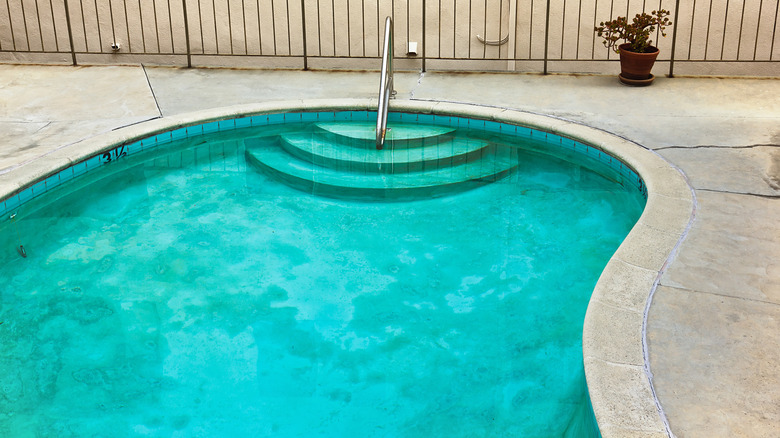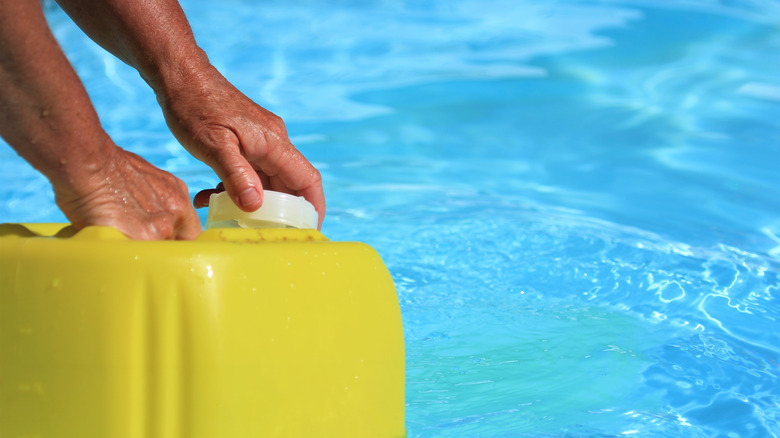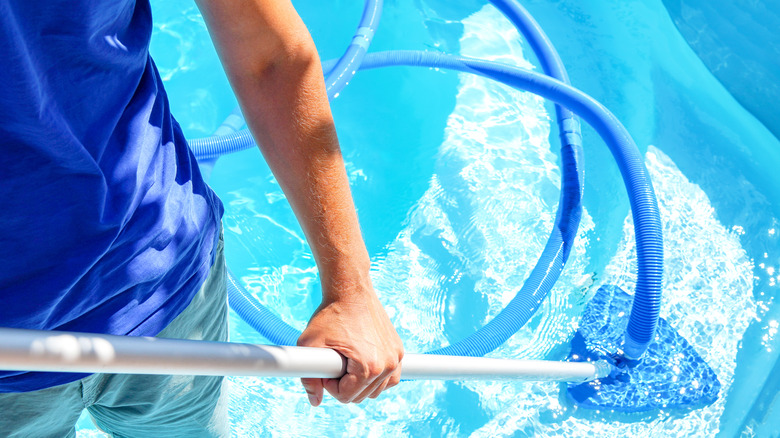What Is Mustard Algae & How To Get Rid Of It
Having a pool in your backyard is a luxury, but with that luxury comes a lot of potential problems that can arise. Before you take that first jump into your watery oasis, you need to make sure you are cleaning it, especially if there are signs that your pool is in dire need. Even then, there are some huge mistakes you can make when cleaning your pool, including mishandling chemicals and not cleaning the filter. Above all else, though, there is one thing in particular that will be the bane of your existence: algae. And while regular algae is enough of a pain, there's something even worse to keep an eye out for.
Mustard algae is a chlorine-resistant algae that lives in pools. Unlike other algae, it can appear at first glance like sand or dirt that easily brushes off — but don't be fooled. To actually get rid of it, you have to do more than simply add more chlorine or wipe it away — you'll need to balance your water chemistry and triple shock your pool.
If you do notice mustard algae, don't fret. Also known as yellow algae, it can actually be yellow, green, or even brown. While it may take multiple shocks, and a bit more of a hassle, your pool will be good as new in no time. Here are the steps to follow to get rid of mustard algae and what you can do to ensure it never returns.
Getting rid of mustard algae is a pain, but you need to go all the way
Mustard algae, once spotted, is already a problem. Unlike the more common algae you're used to seeing coat pool's walls, the chlorine-resistant algae looks more like sand or dirt at the bottom of the pool. Once you do discover it, you'll need to make sure you are covering all your bases so the algae does not return and ruin your summer.
As soon as you identify mustard algae, it's imperative that you take out all pool toys and anything that has touched the pool (this includes bathing suits!) and wash them thoroughly. This is because mustard algae can live outside of the pool and cling to fabrics so if you shock the pool and then jump in with a algae-clad suit, your problems will start all over again.
Once your pool items are clean, it's time to focus on the pool itself. The best way to clean dead algae out of your pool is with a multiport valve, but mustard algae requires much more. The first step is to vacuum and sanitize the bottom and sides of your pool, removing the algae from all surfaces. Once that is complete, ensure your water chemistry is balanced as this will allow the next step to work correctly, which is shocking your pool. Mustard algae usually requires three shocks, or three pounds of pool shock for every 10,000 gallons of water. Shock your pool at sunset and let it sit for 24 hours, retesting your water chemistry as needed.
Stop mustard algae from returning, before it haunts your next summer
Once your pool is fresh and clean, your work is not over. While you can now jump in and enjoy an algae-free summer day, you'll still need to make sure your pool is working properly and keeping the algae away. Your pool's water chemistry is extremely important for this, so always make sure it is correct. This means that your pH should be between 7.4-7.6 PPM, your alkalinity should be between 80-120 PPM, and your chlorine levels should sit at about 1.5 PPM. Many homeowners hire a pool expert to test their water chemistry every week, so if you are doing it yourself, you'll want to check it weekly as well.
Beyond the water, you'll also want to run your pool pump every day, for at least 8 hours a day, and continue to clean your pool by vacuuming, brushing and cleaning any pool toys after use. About once a week, you will also want to go in and shock your pool (just once this time!) to ensure that any algae that may have crept in is killed before it can spread. Having a pool can be a lot of work, but as soon as you dive into the cold, blue water on a hot day, all that work will be well worth it.


